YouGov reveals where Americans fall on the classic D&D alignment table
RPG players and meme lovers will all be familiar with the concept of the Dungeons and Dragons alignment table. The two-axis alignment table as it exists today was introduced as far back as 1977, with one axis running from Good to Evil and the other from Lawful (which emphasizes “honor, trustworthiness, obedience to authority, and reliability”) to Chaotic (which emphasizes “freedom, adaptability, and flexibility”).
Following a previous YouGov UK study on the subject, in March 2021 YouGov asked more than 24,000 Americans to self-identify via two questions about their values in order to determine where they fall on the alignment table.
Now, using YouGov Profiles to examine the results, we reveal the size of each alignment group in the U.S. population, as well as the key differentiators between the respective alignments.
How many Americans are in each D&D alignment group?
As with the Brits, the most common alignment in the U.S. is Neutral Good – that is, people who consider themselves Good but fall in between Lawful and Chaotic – at 29% of the population.
The second largest group is Lawful Good, which comprises one in five Americans (21%).
One in eight Americans are True Neutral (13%) – considering themselves Neutral but falling equally in between Lawful and Chaotic – and 11% are Chaotic Neutral.
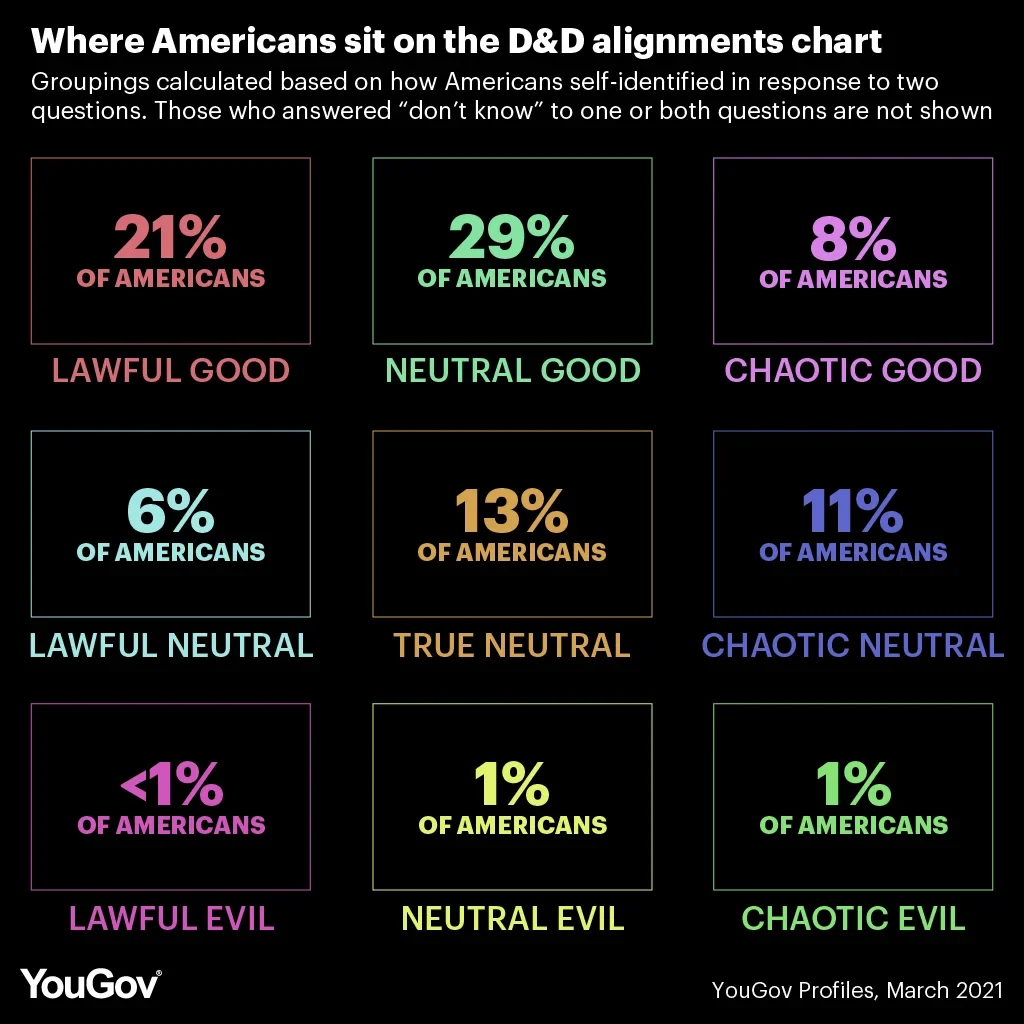
The Chaotic Good group is populated by 8% of Americans, while 6% fall under Lawful Neutral.
Only a very small proportion of people (fortunately) fall into any of the three evil groups: 1% in Chaotic Evil, 1% in Neutral Evil, and fewer than 1% in Lawful Evil.
Alignments by demographic
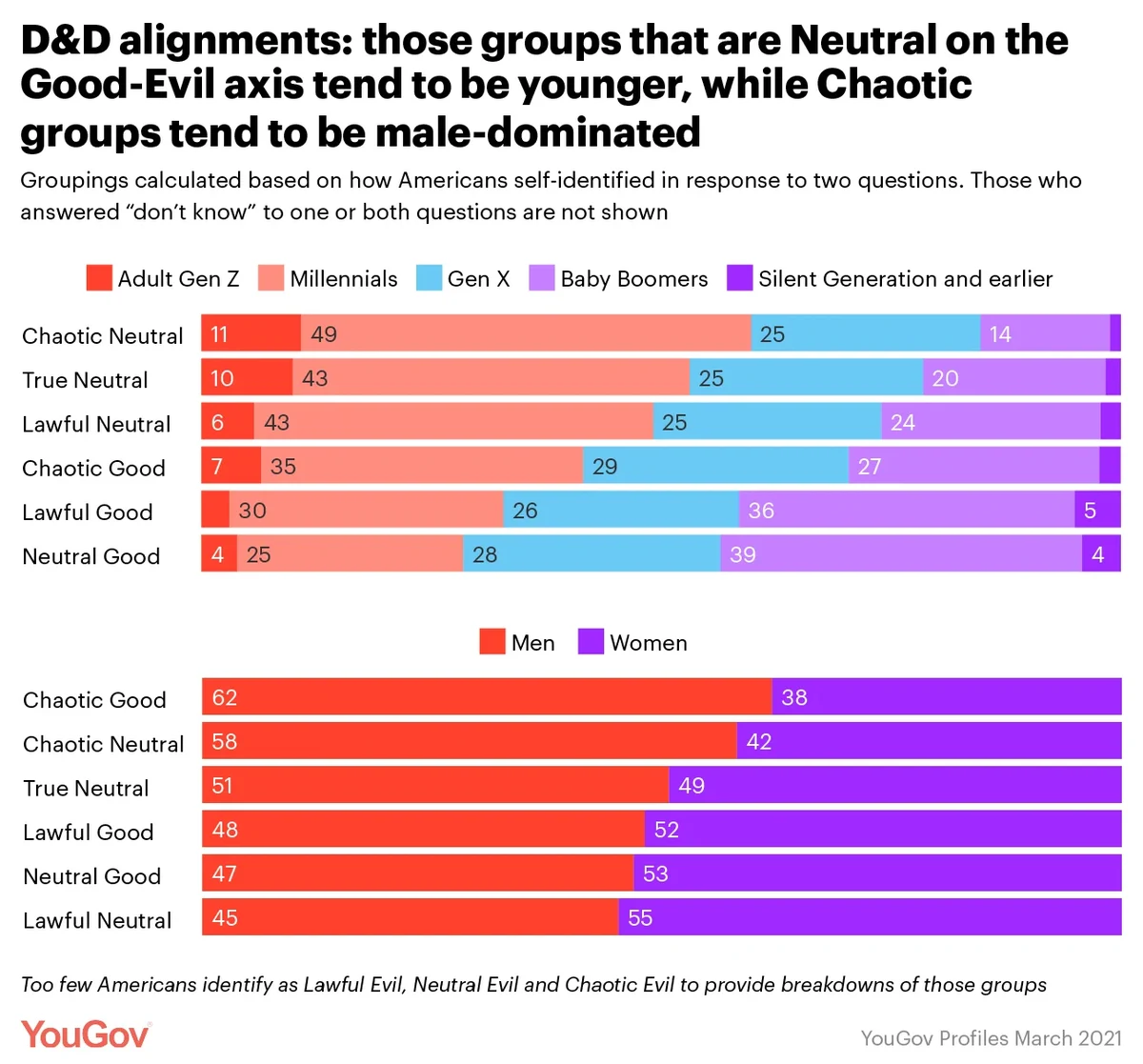
The Neutral groups are more likely to be inhabited by younger generations, particularly Chaotic Neutral, which is 60% Millennial or adult members of Gen Z.
By contrast, older generations are more populous within the Good groups, with Neutral Good containing the most Americans from the Baby Boomer generation or older (43%).
When it comes to gender, the Chaotic groups are noticeably male-dominated, with Chaotic Good being 62% male and Chaotic Neutral 58% male. The group with the most women is Lawful Neutral, which is 55% female.
The alignments by personality
YouGov Profiles contains data on respondents’ views across hundreds of attitudinal statements. Seeing what statements people in each alignment group are most likely to agree with when compared to those outside that group allows us to examine in more detail the philosophies and personalities of the respective alignments.
To show what makes each group most unique, the following data refers to the biggest differences between each group compared to all the other groups.
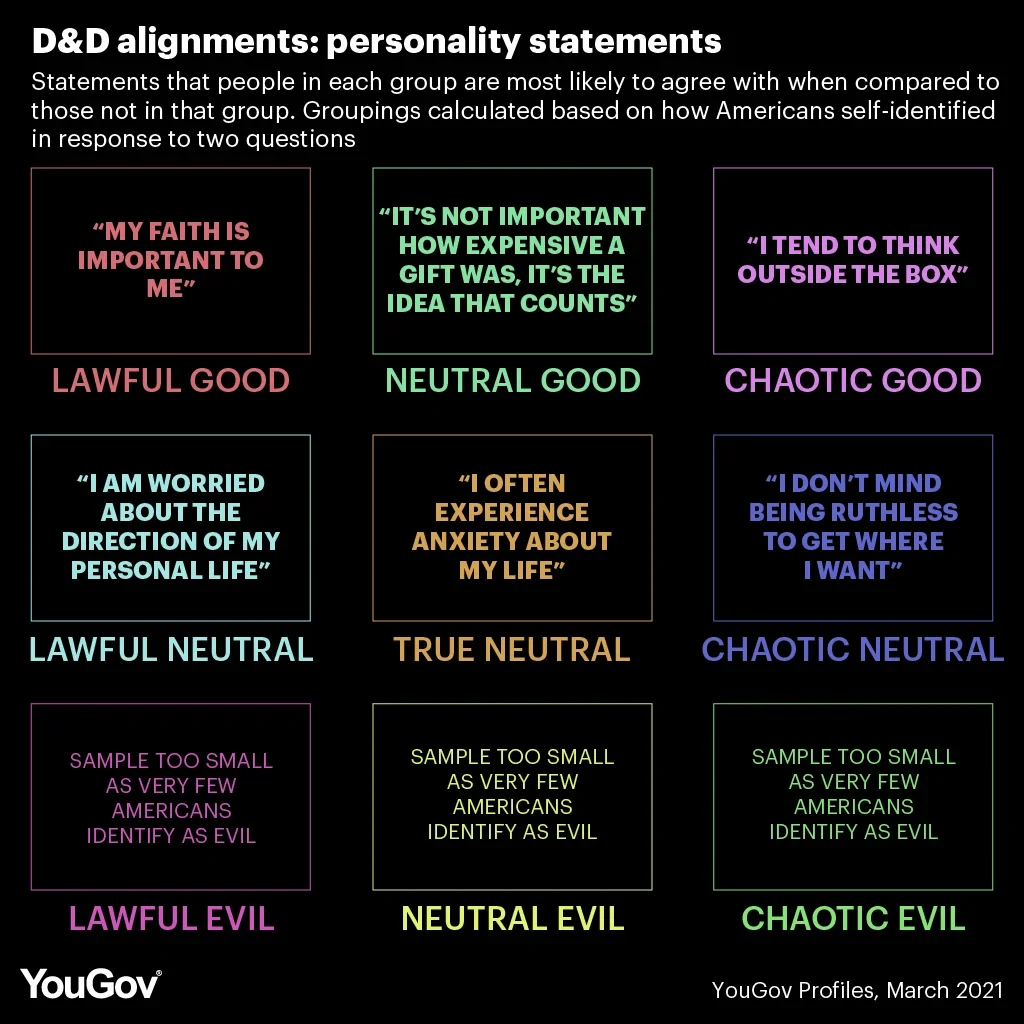
Lawful Goods are clearly more likely to be cleric types, with the statement most strongly setting them apart from the other groups being “my faith is important to me.”
Neutral Goods might make for the best Dungeon Masters as they are most impressed by ideas, their statement being: “It’s not important how expensive a gift was, it’s the idea that counts.” In turn, Chaotic Goods might be the most likely to please the DM and garner inspiration points for their creative problem solving, given that they are most typified by the statement: “I tend to think outside the box.”
By contrast, Chaotic Neutrals demonstrate more rogue-like qualities, taking a more morally dubious approach to problem solving with their “I don’t mind being ruthless to get what I want” attitude.
True Neutrals perhaps suffer existentially for their unwillingness to take sides, being most typified by the statement “I often experience anxiety about my life.” Lawful Neutrals are likewise wracked, although in this case directed specifically towards their personal life.
The alignments by interpersonal relationship priorities
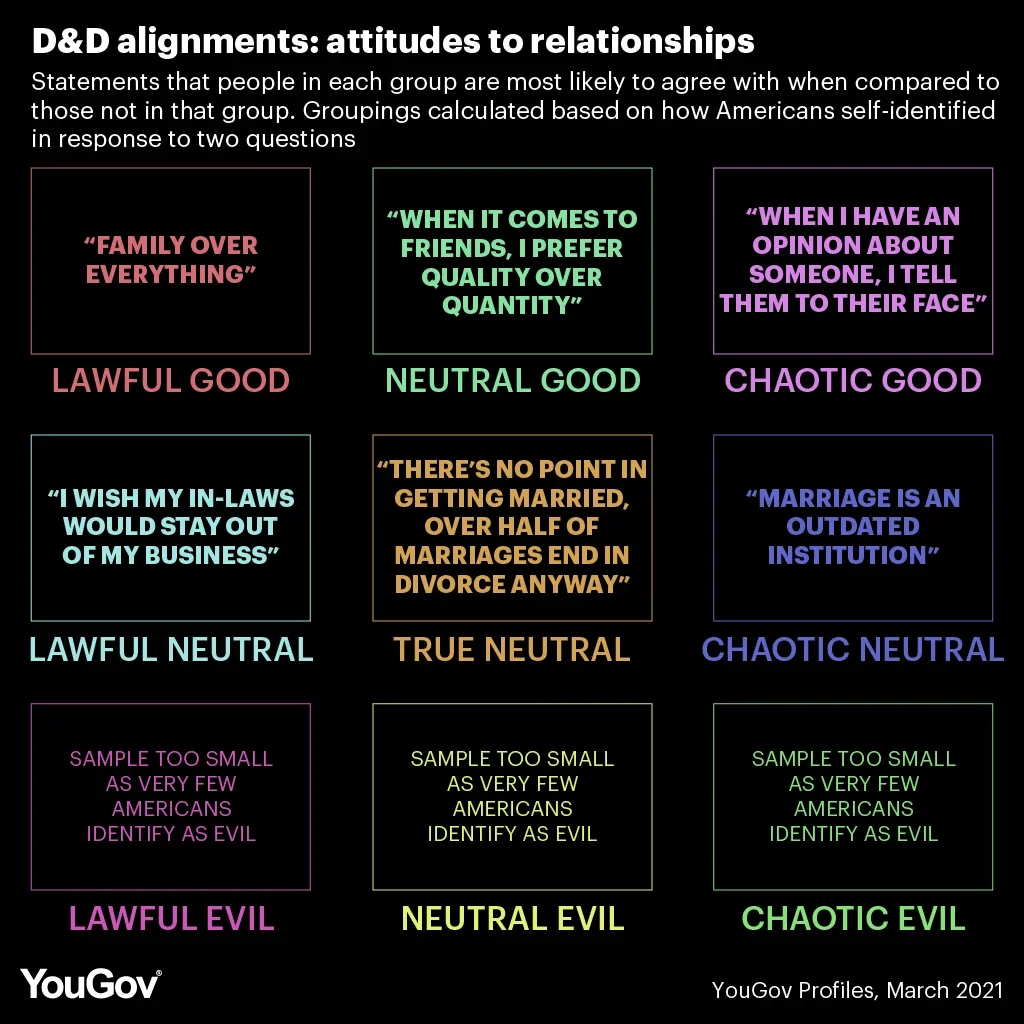
When it comes to how each group interacts with other people in their parties – their nearest and dearest – Chaotic Goods may be the most testing to be around. The statement they are most likely to agree with compared to other groups is “when I have an opinion about someone, I tell them to their face.”
Neutral Goods are most likely to be defined by their attitudes to their friends, with their statement being “when it comes to friends, I prefer quality over quantity.” For Lawful Goods, it’s more about family, with their statement being “family over everything.”
The three groups that are Neutral in the sense of sitting between Good and Evil are most vexed by marriage-related concerns.
Chaotic Neutrals are bothered by marriage in principle, with their statement being “marriage is an outdated institution.” True Neutrals express their concerns more practically, saying “There’s no point in getting married, over half of marriages end in divorce anyway.”
Lawful Neutrals’ concern stems from consequences of marriage, with the issue that sets them apart most from the other groups being “I wish my in-laws would stay out of my business.”
The alignments by political attitudes
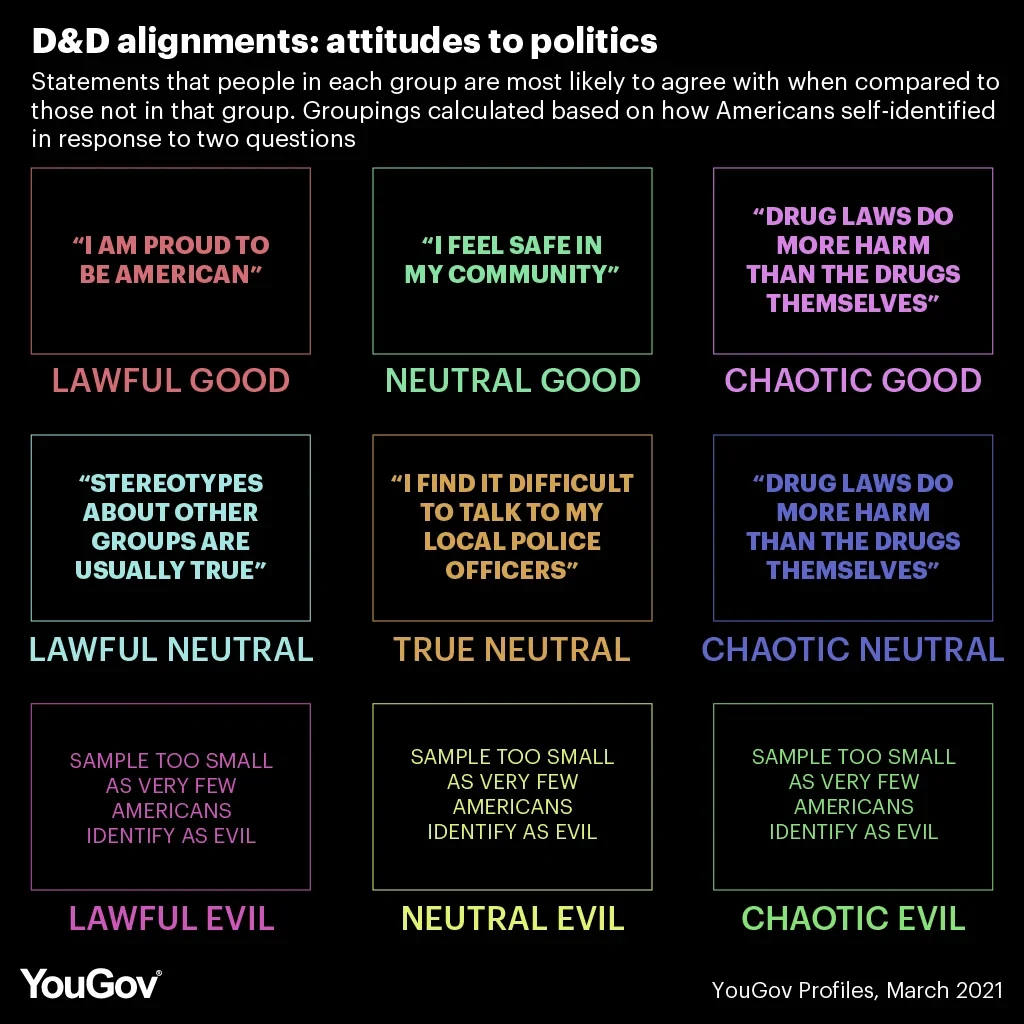
When it comes to the way the alignments look at the world, given their inherent rejection of rules and authority it is perhaps unsurprising that both Chaotic groups – Good and Neutral – are most likely to proclaim “drug laws do more harm than the drugs themselves” when compared with other D&D groups.
For Lawful Goods, patriotism rules the day, with their statement being “I am proud to be American.” For the British study it was actually the Neutral Good group that were most characterized by their national pride.
When it comes to American Neutral Goods the statement that sets them most apart from other groups is: “I feel safe in my community.” By contrast, their True Neutral counterparts have quite a different experience, with their statement “I find it difficult to talk to my local police officers.”
The statement Lawful Neutrals are most likely to agree with compared to other groups is “stereotypes about other groups are usually true.” In the British study, the Lawful Neutral statement was the not unconnected “everyone is a little bit racist.”
The alignments by political issues they describe as most important to them
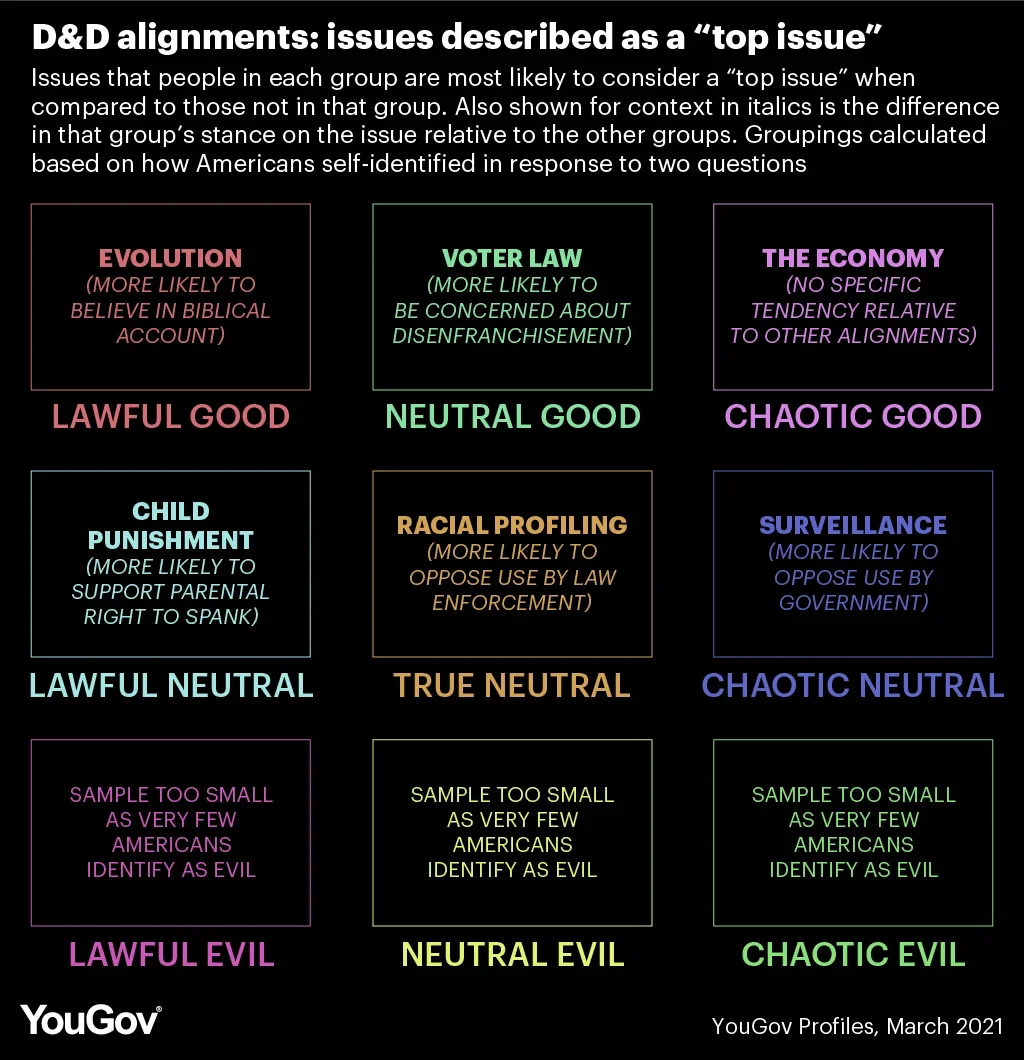
Compared to other groups, Lawful Goods are most likely to say that “evolution” is a top political issue for them. Given their emphasis on spirituality, it is no surprise that they overwhelmingly come down on the religious side of the debate: 51% believe the account in the Bible to be literally true, while a further 19% believe in intelligent design.
The issue their Lawful Neutral counterparts consider to be a "top" matter relative to other groups is "child punishment," implicitly taking the corporal punishment stance, being that 71% support the right for parents to use mild physical punishment.
For Chaotic Goods, a focus on the government’s role in the economy sets them apart from other groups (33% say it is a top issue for them, vs. 22% for everyone else). In this case, however, this is not driven by people who fall more on one side of the debate than the other within the Chaotic Good group, but rather it seems a tendency among Chaotic Goods to consider the issue important in general regardless of their stance.
Chaotic Neutrals are more fixated by the importance of "surveillance" as an issue (53%), with the group being more anti-surveillance than other alignments (42%).
Neutral Goods are most like to see "voter law" as a top issue compared to other groups, being more concerned about denying eligible voters the chance to cast their ballot (50%) than the rest of the population are (41%).
For True Neutrals the top concern that sets them apart is "profiling", with 66% vs. 59% saying it is “definitely not” okay for law enforcement to stop and search someone partially on the basis of their race.
Methodology: Total unweighted sample size for the two alignment questions was 24,209 U.S. adults aged 18+. The survey was conducted March 3 - April 1, 2021.
All data accompanying the two alignments questions is gathered via YouGov Profiles. Profiles is based on continuously collected data and rolling surveys, rather than from a single limited questionnaire. Profiles data is nationally representative and weighted by age, gender, education, region, and race. Learn more about Profiles.











